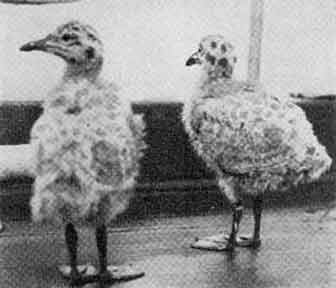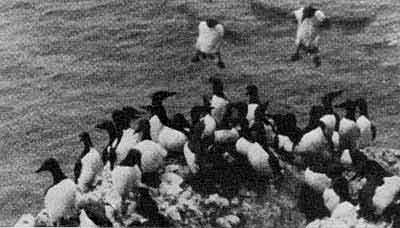Digging For Birds
By ARTHUR NEWTON PACK
Nature Magazine, March 1932
Somehow or other, on my hands and knees, I managed to crawl up that cabin stairway. It seemed to my disordered mind that there might be some ray of comfort in dying in company rather than alone. Faintly I recognized Mrs. Pack and two or three other members of the American Nature Association's party lying flat on the cabin floor. Smash! Over went the water pitcher on someone's head. The drenched recipient of the deluge only rolled over to get out of the way. Crash! The heavy tripod of my motion picture camera broke loose from its fastenings and toppled over, missing my head by not more than an inch. I remember distinctly that I only groaned. It was now early afternoon. The storm had been getting heavier ever since daylight, and the Westward was not due to make Forrester Island until ten in the evening and this assuming that the storm did not hold her back still further. Dr. Brown staggered by. He was still able to use his legs, which was more than I could do. "Doctor," I called, "if you can get to the pilot house, tell the Skipper I think we had better run for shelter behind Dall Island and give up Forrester fat the present." With this tremendous effort at directing the expedition, lance more collapsed on the floor. A moment later the Westward gave a great lurch and then began to roll widely, but the pitching had eased a little. Evidently, my message to the Captain had been delivered and the course was changed. Four or five hours later, when the yacht ran under the lee of Dall Island, the passengers began to sit up and realize that this was not death, after all, although some had hoped for such release.

TWO YOUNG GULLS SURVEYING THE SCENERY
It had been our intention to make a run of one hundred and twenty miles straight by sea from the mainland at Prince Rupert, British Columbia, to Forrester Island, a sea-bird refuge administered by the United States Biological Survey, and one of the most outlying of all the islands of southeastern Alaska. Thanks to the performances of the misnamed "Pacific" Ocean, it was nearly three days before the eighty-six-foot Diesel yacht, Westward, with our party on board, achieved her destination. Forrester Island affords practically no harbor. When the wind is from the west there is refuge on the eastern side, but never any cessation of the rolling swell. Captain Dykeman found an anchorage, after careful soundings; and, after lunch, the camera hunters with the small outboard motor boat started out to explore the coastline and search for bird colonies. From our anchorage we had already had our first glimpse of tufted and horned puffins, those parrots of the sea; and all the rocks were well lined with gulls and cormorants. Now, as we purred swiftly along the rocky shore, little pigeon guillemots with red legs took off from the heaving swells in front of the dancing boat or dived noiselessly beneath the surface. A pair of bald-headed eagles screamed at us from their lofty perch in the top of a dead fir, while two younger eagles circled about. The frowning shores were steep and precipitous, with bare cliffs rising about thirty feet. Above them showed grassy banks honeycombed with the open mouths of burrows where the puffins lived. So long as the swells continued, no possible landing place offered.

MURRES PERCHED ON THE ISLAND EDGE
Forrester Island is four and one-half miles long, and at its upper end breaks off into tumbled rocks where the swells from the open ocean dash into spray. Our little boat rose and fell, but with a motion far more pleasant than the long roll of the Westward. At the lower end, between Forrester Island and Petrel Island, is a narrow opening, and nearby a sort of rockbound bight with a barrier of kelp. This might afford a chance to land. The Skipper drove the boat towards the narrowest place in the kelp barrier, raised the outboard engine, and we coasted through, while one man grabbed the oars. Then followed twenty minutes of juggling with the swells. Stern first, the boat would approach a low rock and, at the proper instant, one person at a time would jump for shore; then more juggling followed until another lull in the swells came. At last all of our little party stood on the rocks with the cameras safely beside them, and the Captain set about the task of anchoring the launch clear of the rocks. It was necessary to fasten her both bow and stern, the stern to an anchor and the bow to the shore, and this was no easy task. After that the man who anchored the boat had to get ashore.
 Printer-friendly version
Printer-friendly version
